How to Make a Video Online for Free Quickly and Easily
Monetizing content and building followers are among the gazillion things a content marketer dreams of. But what if your videos are not as useful to pique attention? Would you blame your luck or would you instead put in the effort to learn the video-making essentials?
If you’re looking to build upon video-making essentials, you’re in the right place. In this article, you’ll learn how to make a video online not just for free but also create videos that speak to your target audience like they are seated across the desk.
So, let’s get started quickly.
How to Make a Video Online for Free
Creating a video is relatively easy with Typito and can actually take only a few minutes.
Step 1: Signup and create a video project
- Go to typito.com and signup for a free account. You can sign-up using your email ID or Google or Facebook. Choose whatever is convenient to you.
- Once you sign-up, you will be redirected to Typito’s homepage. Click New Project.
- Next, you will see a list of video formats. Click the format that you want to create your video in by pressing the create button.
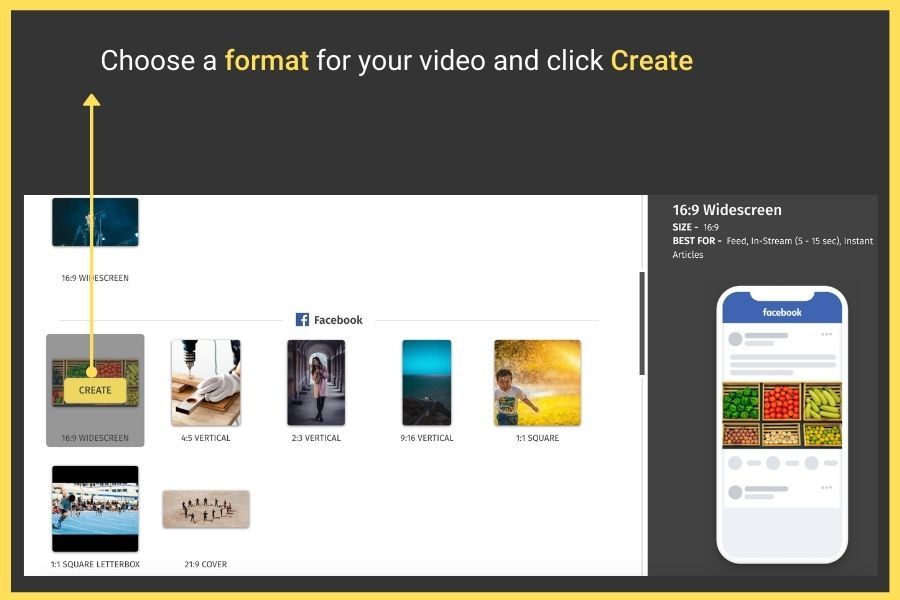
- If you don’t want to use any predefined formats shown and prefer creating your own, click on the button that says Create Custom Format on the top.
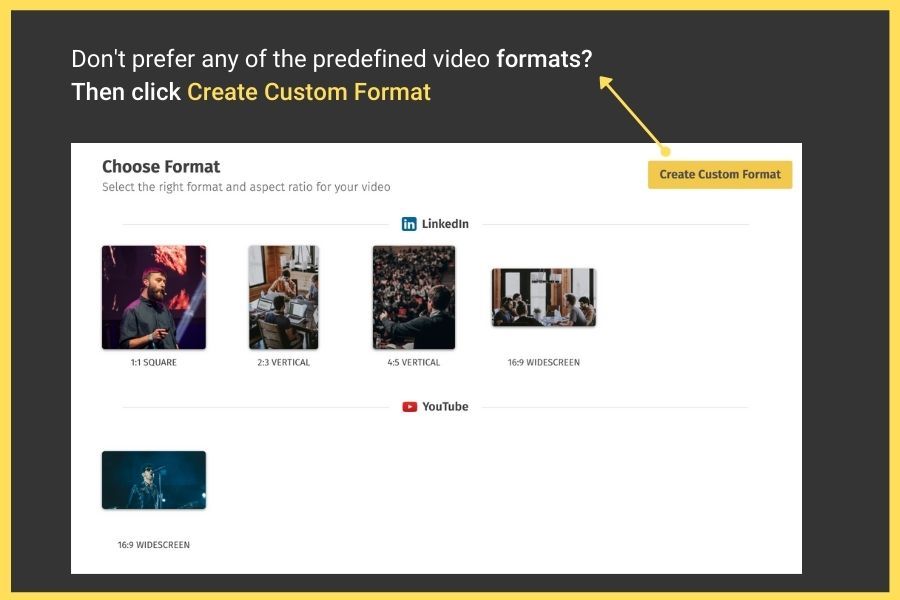
- You will see a pop-up, where you can enter the video format’s name, purpose, width and height (in pixels), and padding (in %). Once you have entered all the details, click Create.
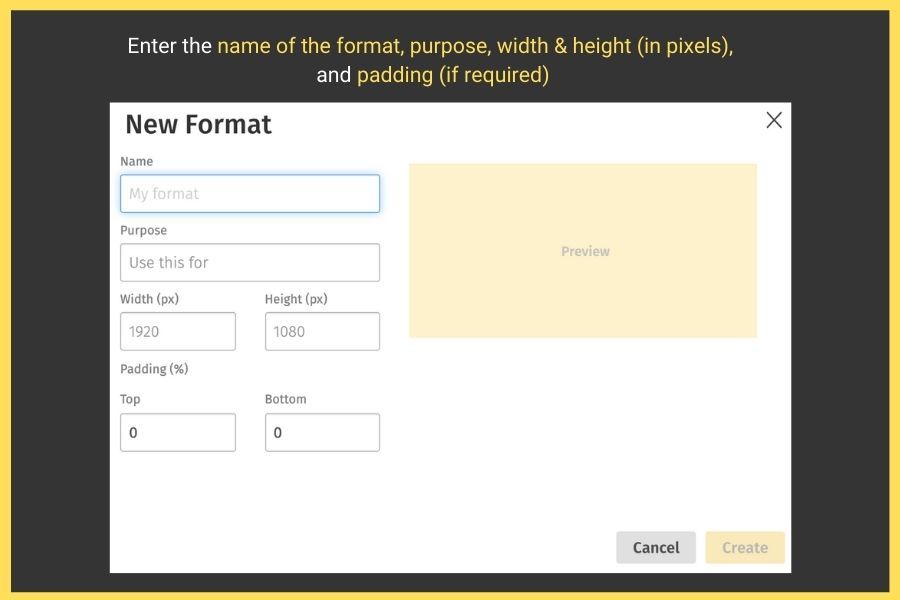
Step 2: Upload the video from your computer or choose from the stock media library
No matter what video format you choose (whether it is YouTube, Linkedin, Instagram, Twitter, Facebook, or Custom), you’ll be redirected to a page that gives you 2 options to import a video:
- Upload: Lets you upload a video from your computer
- Stock Media: Lets you select a video from the integrated stock footage library
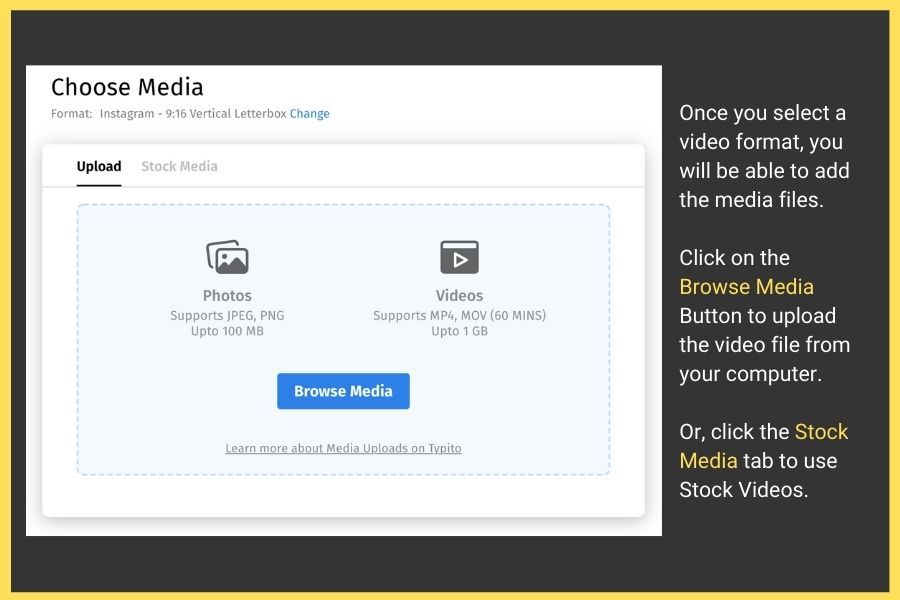
Pro Tip: You can do two things here:
- Make a video using just pictures and music (See here)
- Or, upload your raw footage that you had shot with camera and make it look professional by using Typito’s inbuilt features
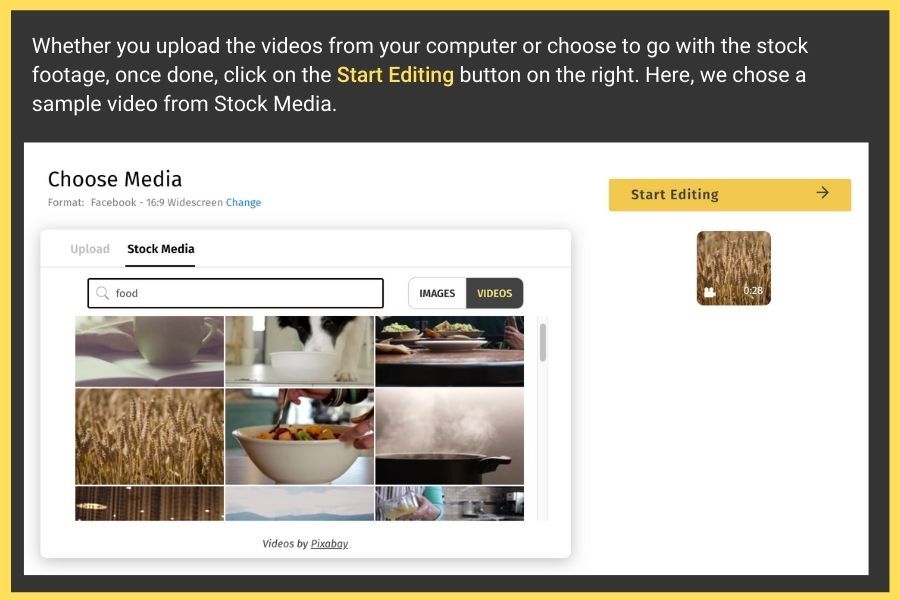
Based on the size of the uploaded video, the importing process takes anywhere from a few seconds to minutes. Once that’s complete, click on the Start Editing button from the right.
Step 3: Edit the video to give a professional touch
You’ll be redirected to Typito’s user-friendly dashboard with the uploaded footage in the same format (or dimensions) that you had chosen.
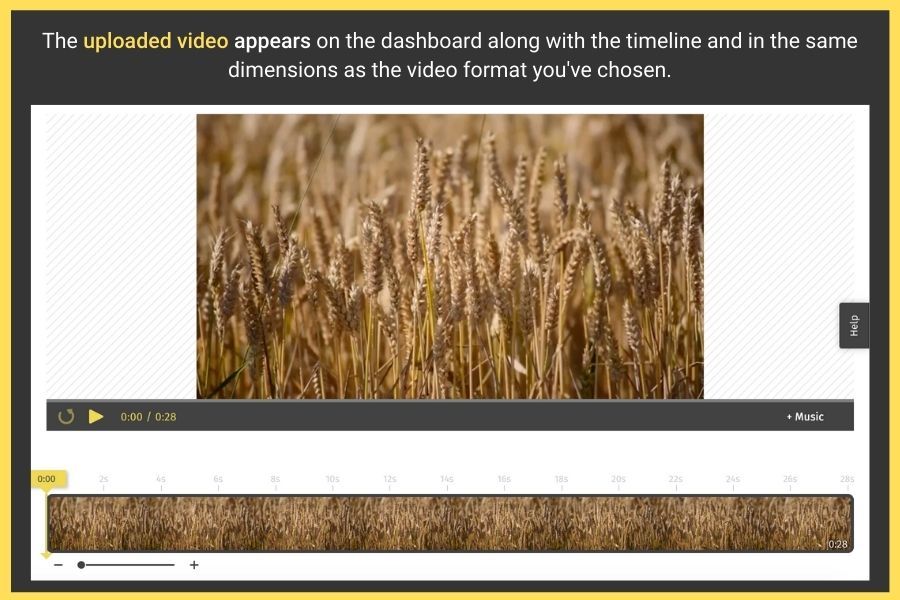
You will see 5 tabs that allow you to add the essential elements to create an engaging video in the left panel.
- Text on Video - Titles, Lower Thirds, & CTA
- Image Overlays
- Add Music or Audio
- Video and Image Clips
- Subtitles or Closed Captions
Here’s a quick look at what each of these elements can do to enhance your video.
1. Adding text on your video
Adding text to your video is fairly simple with this option. Here’s what you need to do:
- From the left panel, click on the Text tab.
- You’ll see an array of predesigned text templates to pick from. If you’re a newbie and probably don't know where to start from, we recommend you choose any one of these stylized text templates. These include basic as well as animated text templates.
- To apply the text template to your video, click on it once.
- Once your text template appears on the video working space to the right, you can further beautify it by changing the font style, color, size, alignment, letter space, line height, etc. Besides these, you can even add animation effects to the text.
The “text” feature also includes a few other sub-categories like:
- Titles: Opening your video with a big bold text title secures a great first impression for your video. Choose a template that fits your video from the title templates collection.
- Social Media: Adding social media CTA are a great way of showcasing your brand presence across multiple platforms. You can add CTAs for viewers to follow you, depending on which social media platforms you're most active on.
- Lower Thirds: Consider adding text captions placed at the lower half of your video to engage users watching your video on mute. You can choose from the various animated text templates to give your video a more professional stylized touch.
- Branded: If you have a logo for your brand or particular fonts associated with your branding this is something you should definitely use in your video. Each of the branded templates makes it easy for you to add a logo to your video titles.
Just clicking once on any of these text templates will let you add it to your video working space on the right. You can then drag and place it wherever you want to.
2. Adding image to your video
There might be times when you might need to add a few images, shapes, or icons in the middle of your clip for more context or simply overlay an image of your logo on your video.
Here’s how you can easily add an image overlay, shapes or icons to your video:
- From the left panel, click on the Images tab.
- You will now see 3 options: Shapes, Icons, and My Uploads.
- Shapes and Icons: Includes an array of predefined geometric shapes you can use in your video.

- My Uploads: This lets you upload your own logos or icons that you want to use in your video.
Click once on a template to add it to your video on the right.

Music plays a key role in increasing engagement for your videos. This is particularly true if you’re creating a video without any text, captions, or captivating visuals.
3. Adding audio to your video
From creating a good intro, to adding tracks based on the mood, or adjusting the volume of the background music- you can do all of this with just a click.
Here’s how you can add audio to your video:
- From the left panel, click on the Audio tab.
- You’ll see two options: Library and Uploads.
- Library: The audio library has over 150+ royalty-free tracks that you can add to your video. You can browse through multiple genres/categories like - food, fitness, corporate, adventure and more, to choose a music track to find apt music for your video.
- Hover over a track, click the play button to preview and if you like what you hear, click the +Add button to add it to your video.
- Upload: If you’d like to upload your own track simply click the Upload button and choose your audio file from your computer.
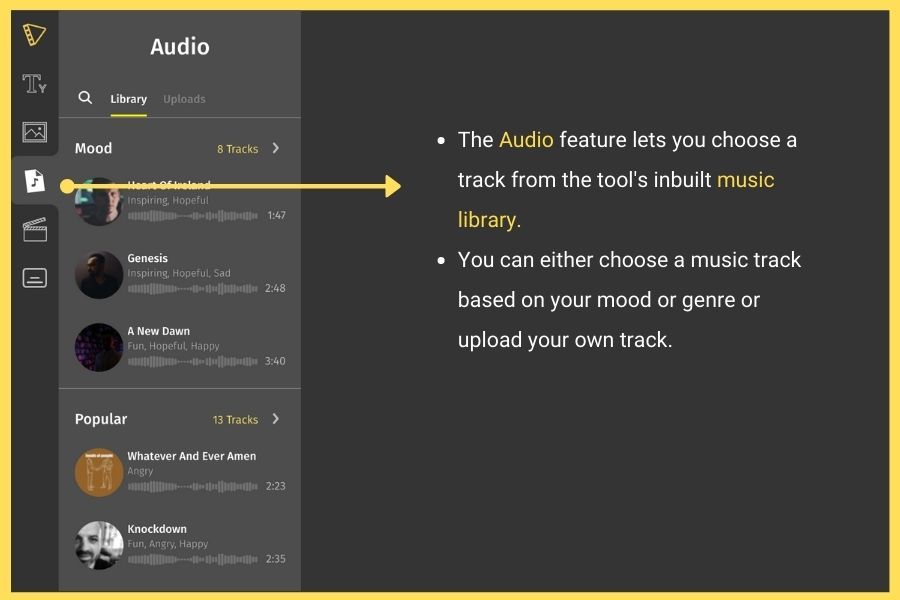
- No matter how you add the music, the moment you apply it, you’ll immediately get a pop-up with an option to trim the audio with the help of a draggable slider. This lets you use a specific part of the audio to the video.
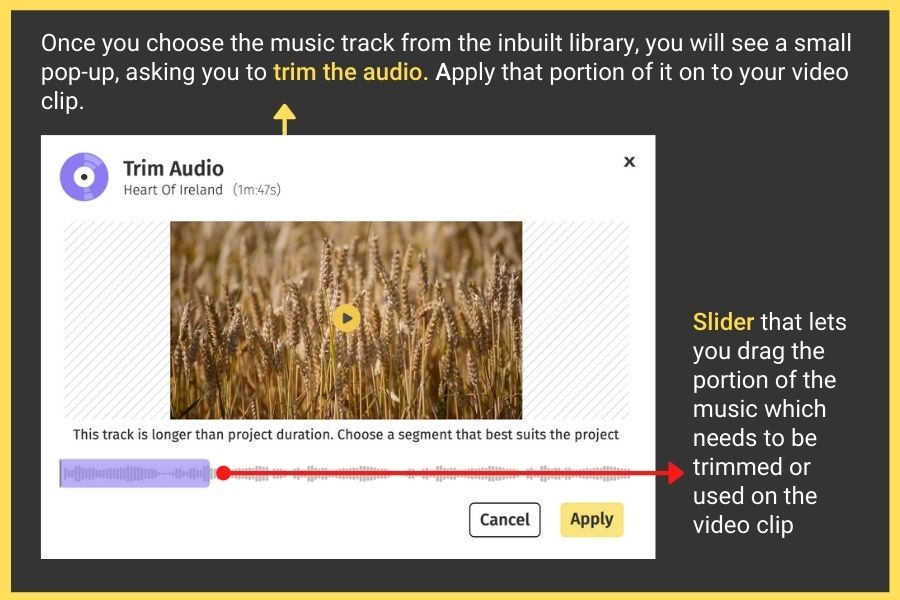
- After you add the music to the video, you have the option to change the volume of both background and music anytime.
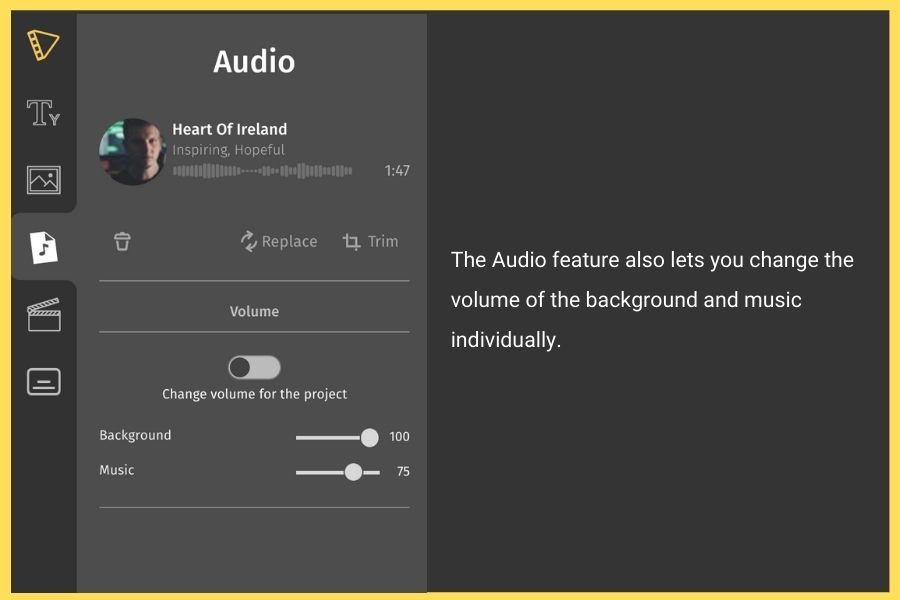
5. Adding images to your video
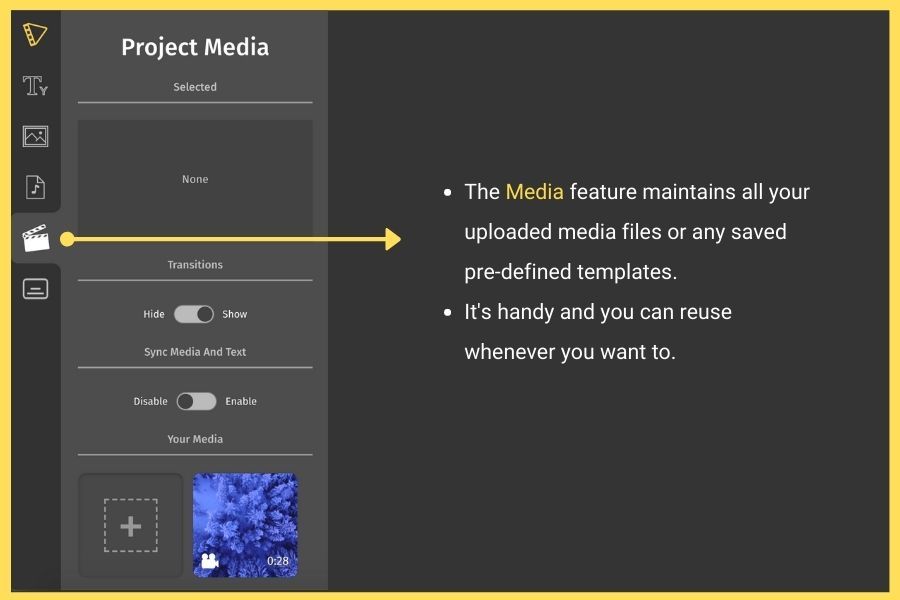
The Media section allows you to upload images or more video clips and stitch these together to make a video - like a slideshow or image clips with some transition effects or video compilations.
6. Adding captions to your video
Captioning is a great way to make your videos more accessible and engaging. It allows hard-of-hearing and d/Deaf individuals to not just watch and enjoy your video content but also ensures that they remember the information more easily. More than that, it’s also great for people who prefer watching videos in sound-sensitive environments.
With Typito, adding captions is easy and straightforward. Here’s what you need to do:
- From the left panel, click on the Captions icon.
- You will see a wide array of basic and stylized text templates.
- Choose any one of the text templates that you like to add to your video and click once.
- This gives a preview of the way it looks on the video.
- You will also see something called Position, which is basically an option to align the captions to top, middle, or bottom.
- Once you’ve aligned the captions, the next step is to click the “Next, add content” button.
- You will then be prompted to add the content for your captions.
Step 4: Export the video and download
After you have played around with all the features and perfected your video, you just have to download it. To do this, follow these steps:
- From the top right corner, click on the Export button.
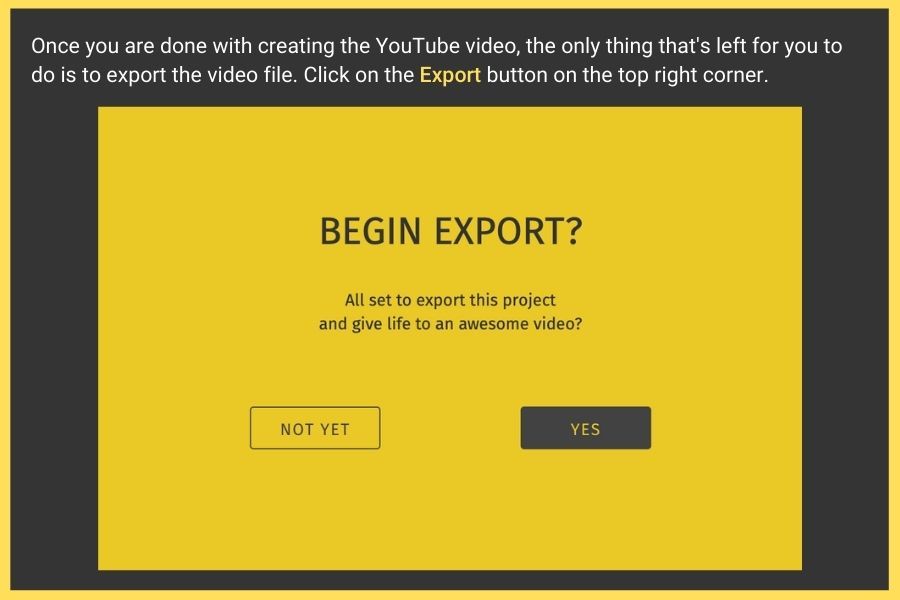
- Your video begins to export. This takes from a few seconds to minutes, based on your video size.
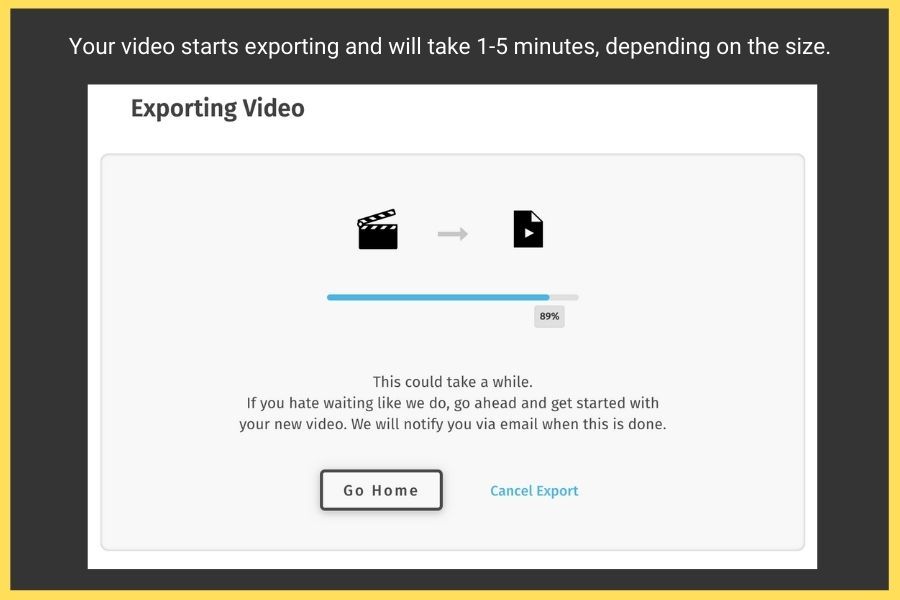
- Once that’s complete, your created video is ready to be:
- Downloaded in HD format and saved to your local drive
- Published to your YouTube channel directly
- Shared on Facebook
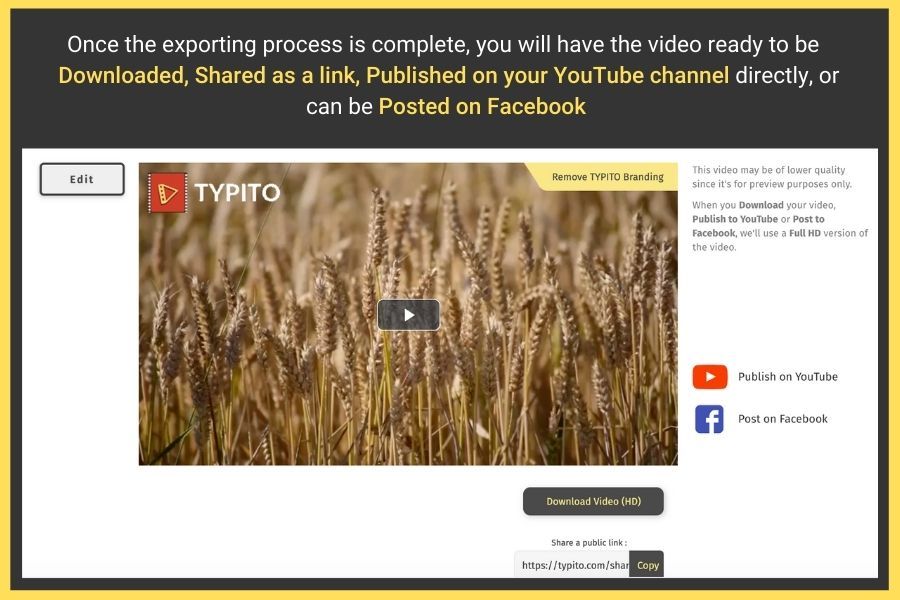
Now that you have learned how to make a video online for free, learn a few more essential video-making tips before you start making one.
Tips to Keep in Mind While Making a Video
If you’re nervous about making your first video, you aren’t alone. Most aspiring vloggers and videographers face the same hurdle after starting a YouTube channel or video project. Most of them can’t seem to understand how to make riveting video content with a modern vibe.
If you’re among the aspiring stars and cinematographers, here’s a chance you wouldn’t want to miss because in this blog you’ll learn the tips to keep in mind while making a video. So stick around till the end as we walk through the essentials that you’ll need even before getting started.
A lot of preparation goes into pre-production to get each shot right so that you don’t have to take the same path twice. My approach in this blog is to break down the process into smaller bits so that you can pause and practice each technique as you scroll.
Not to sound preachy, but you don’t have to spend a whole lot of money to become a professional video maker. At least, your first video needn’t be shot on a high-end camera, even a mobile phone makes a great tool to get the video professionally shot and edited with an easy-to use video editing tool like Typito.
Legends Make Videos and Not Clickbait
Congratulations on taking baby steps to launch your video project. The next stage is getting smaller things sorted. That includes brushing basics and keeping tools handy to start and finish the project within a stipulated time.
So without ado, let’s begin with tips that nobody talks about.
1. Light Brings Videos to Life

In cinematography, light shapes mood. It adds production value and makes the video richer and expressive. A soft light hitting the face brings the focus onto an object or character in your video while a bright dispersed light is more straightforward and general.
A misplaced light source clashes with the quality of the production and makes the video seem budget-strained. Natural light is strangely appealing in videos so shooting during the early hours and evening adds drama to scene composition.
At all costs, avoid shooting in piercing bright midday light to avoid dealing with unflattering shadows. It’s every video editor’s nightmare. While shooting indoors, experiment with symmetrical lights to illuminate the face and add intensity to the scene.
If you’re shooting marketing videos always leave the face well-lit for a positive vibe. If you’re taking the pro steps, it’s worth trying the lighting triangle to let the light flow around the features of your subject to create a pleasing composition.
2. Use Background to Compose Scenes

The background in a video is just as important as the foreground. If you are planning to compose a professional shot, choose the background wisely, and remove all distractions from the scene. Use a solid backdrop like heavy drapes and decorative paper to fill the void.
The most important thing is to make sure to place actors away from the backdrop to avoid inadvertent shadow casts. If you can’t make do with props available at home, rent a studio to use as a filming set.
When shooting at unfamiliar sets, be aware of reflective surfaces and window panes that reflect equipment or behind the scene crew. Moreover, placing actors near windows where outdoor light enters can cause unnecessary silhouettes.
3. Pick a Video Editor to Improve Quality

So you’ve got the production completed, what’s next? Raw footage is not a presentable material on its own. It must go through post-production where editors transform the footage by adding flavors like SFX, VFX, and also editing away unnecessary bits to arrive at a final version.
Even if you’re a beginner, make sure to use simple editing tools to make your footage appealing. These can take your video processing to whole new heights.
Some of the simpler features that you can exploit from free editing tools are text inclusion, cropping, scene transitions, and modifying aspect ratios. Some mid-tier versions also support filters, overlays, as well as stock audio and video.
4. Don’t Overdo the Edits

When you try the editor for the first time, be prepared to feel overwhelmed by its features. Only pick effects that increase the production quality and discard the rest.
In most scenarios, your footage may not need one or any effect at all. It’s always better to avoid going overboard with edits.
However, a few things are mandatory - Like using noise cancellation to remove background noise, adjusting brightness, cutting unwanted pauses, adding cool transitions, and BGM.
5. Use Audio to Make an Impact

Have you ever had to click a YouTube video and then immediately close it because of bad audio? It’s wired into humans to reject unappealing content, especially the audio.
Most people are patient enough to watch videos that may not be HD or if videos appear slightly grainy. But distorted audio is enough to make them pay no heed. So before making your first video, make sure you have set aside a small budget for an external microphone.
If you aren’t short-strapped, it won’t hurt to spend a little more on an HD microphone. After recording the audio from an outdoor location, edit away distractions like birds, wind noise, and traffic to call the viewer’s attention to a particular activity.
6. Use Image Stabilization

One important thing to remember in video-making is to record visuals without making viewers feel dizzy or seasick. Unless it’s part of the script, jerky videos will have people cursing you for not using a stable platform.
If you have shaky hands or aren’t set up to shoot hand-held, it’s best to set down the camera on an immovable surface (or use a gimbal or tripod if you have money to spare). Your skill will be put through paces when panning the camera. The smoother you do it, the more professional it seems.
However, if you can’t pan without ruining the production quality, consider changing perspective by cutting shots and making transitions.
If you still have shaky scenes in your master footage, use a video editing tool with image stabilization to fix the flaw. It’s mostly a one-click operation so it isn’t an exhausting effort. Alternatively, you could shoot using a video camera with built-in image stabilization.
7. Use Rule of Thirds to Compose Shots

If you insist on taking a professional approach, go with the rule of thirds to achieve pleasing footage.
According to this technique, the subject is placed along with the intersecting points on the grid lines. That is where the camera sensor captures the best details. It also adds a cinematic effect to the shot than having the subject stand in the dead center.
However, the rule of thirds isn’t always a textbook approach. It’s only a creative step to achieve unconventional results. If you’re a budding video maker, this is one of many important skills that’ll come in handy when regular shots start to seem unsuited.
8. Your Phone is a Great Video Making Tool

Thanks to Apple and its iPhone series, mobile photography exploded into a fad that people still follow. It’s a new genre where you don’t even have to own a DSLR to capture visuals. Instead, professional shots are conceived using just a mobile phone.
With manufacturers cramming more megapixels they can to phone sensors, it’s gotten better for end-users. Although not a replacement for pro SLRs, it does unarguably well compared to entry-level and mid-range SLRs. But be mindful of caveats if you’re going with mobile videography.
Shoot using the main camera because that’s where the sensor is bigger. Most selfie cameras on high-end mobile phones don’t fare as much as the main rear camera.
Shoot in the landscape to achieve the 35mm effect. It captures more details that improve video production quality on a larger screen. If possible use the overlay grid to maintain the level.
9. Create a Production Plan Before the Shoot

Above everything else, it’s important to meticulously prepare a plan beforehand to avoid last-minute changes. Impromptu shoots are great for a family occasion where moments weigh more than precision.
But if you’re stepping into the world of professional cinematography or if you want to make a career out of film-making, the complete schedule must be well-coordinated to avoid expenses from adding up due to disruptions.
Plan your production in stages and make sure to note progress, meeting deadlines, and time management. If you need a leg up in setting a basic production timeline, here’s what you need.
Start with production goals. Prepare questions like what you want to convey through your script and who will watch it and how your video will speak to viewers.
Whether shots will seem like a first-person/third-person perspective or a different one that isn’t tried before matters in production. You’ll be confronted with more questions as you get started and build momentum.
Once your goals are set, begin with scriptwriting and storyboarding. Most first-time video makers rush scriptwriting and stop abruptly when they’ve wandered off from the focus. It’s a learning experience, so don’t hesitate to revise portions till you’re satisfied with the way your script sounds when read out loud.
Here, being concise is the key to keep the audience riveted. Don’t prolong narrative portions unless it has any production value.
With the attention span of a goldfish, most content consumers would want excitement when the button is punched. They tend to become impatient when the plot slows down before getting to the interesting bits.
Conclusion
If making a video has been your life-long passion, get started now and use these tips to sharpen individual bits of production to make you make your video praise-worthy. I am sure, doing so will help you become a great filmmaker in the days ahead.
Most newbie filmmakers go through a vicious cycle of reworking their approach till it’s polished to perfection. Don’t forget to emulate the methods of rule-breakers because there is no single right path in video-making.
Modern video makers are constantly exploiting props and stage elements in bizarre ways to make shots shimmer. They do so, by deliberately deviating from traditions to get their work nominated for outstanding elements.
Someday, you could become an innovative filmmaker with a signature style that your movies will be associated with. So work persistently, and learn from mistakes to perfect your shots.




